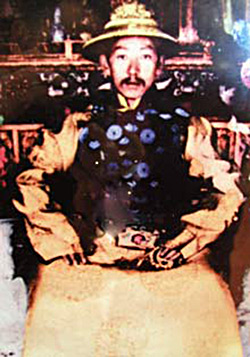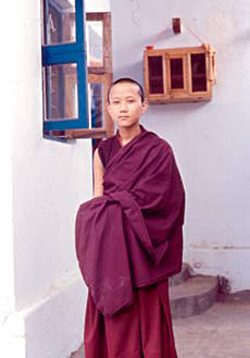by José Ignacio Cabezón and THL.
Ordinary Monks, LamaBla mas and “Religious Devotees”

The Fifth Rwa sgreng rin po che, d. 1947, the regent of Tibet who served as temporal ruler between the Thirteenth and Fourteenth Dalai Lamas. He was one of the highest lamabla mas of SeraSe ra.
The most important spiritual/metaphysical distinction was that between
- lamabla mas and
- ordinary monks (drapa kyümagrwa pa dkyus ma).
The word lamabla ma is the Tibetan translation of the Sanskrit guru. Technically, anyone who serves as the spiritual mentor of anyone else is a lamabla ma. In GelukDge lugs monastic parlance, however, lamabla ma is essentially synonymous with recognized incarnation (yangsiyang srid, or trülkusprul sku), that is, anyone who is recognized as the reincarnation of a previous teacher.26 The present Dalai Lama has on numerous occasions stressed that this is a bad precedent, claiming that the two terms – lamabla ma and trülkusprul sku – are not synonymous. There are, he says, lamabla mas who are not trülkusprul skus (the great scholars who have earned the status of lamabla ma by virtue of their scholarly and spiritual accomplishments, but who are not recognized as the incarnations of previous masters), trülkusprul skus who are not lamabla mas (people who, while having the status of lamabla ma, have no true knowledge or spiritual accomplishments), there are also obviously people who are both (great scholar-saints and trülkusprul skus), and people who are neither.
LamaBla mas were further subdivided according to their rank. In order of decreasing rank/status these were:
- lamabla mas who were incarnations of previous kings/regents (Gyeltrül Hotokturgyal sprul ho thog thu)27
- lamabla mas of the Great Assembly (tsokchen gyi lamatshogs chen gyi bla ma),
- lamabla mas of the college (dratsang gi lamagrwa tshang gi bla ma), and
- lamabla mas of the regional house (khangtsen gyi lamakhang tshan gyi bla ma).
LamaBla mas could also be distinguished according to whether they were “great, medium or small” (lama chekhakbla ma che khag; dringkhak’bring khag; chungkhakchung khag), a classification scheme that overlaps with, but appears not to be identical to, the first scheme. Ordinary monks were in essence all monks who were not lamabla mas.28

A young lamabla ma of Sera Jé, who holds the rank of lamabla ma of the regional house. Photo taken at SeraSe ra-India in the early 1980s.
Despite the apparently strict, hierarchical nature of the lamabla ma/ordinary-monk distinction, this did not always play out in day-to-day life as one might expect. True, lamabla mas (especially lamabla mas of the highest rank) were respected in a variety of ways, but in the densagdan sas they also had to prove themselves intellectually. lamabla mas were not exempt from attending debate, and in the debate courtyard what mattered was not one’s status, but one’s mastery of the material, and one’s skill as a debater. Very high lamabla mas may not have always been slandered or jeered at in the heat of a debate the way that ordinary monks were, but they were otherwise treated the same as other monks. Where they did have some advantage – or where they enjoyed special, exceptional treatment, or miksédmigs gsal – was in obtaining official places (the right to debate) in the so-called yearly “Lesser and Greater Lineage Debuts (rik chechung tsoklangrigs che chung tshogs lang).” They also enjoyed some advantage when it came to the selection process in the final stages of obtaining the geshédge bshes degree, progressing more swiftly than ordinary monks. Of course, since lamabla mas were almost invariably wealthier than ordinary monks,29 they enjoyed greater leisure that, in theory at least, they would spend in study. Many lamabla mas also had the ability to pay for a live-in tutor (yongdzinyongs ’dzin), a senior monk who resided in, and was supported by, the lamabla ma’s household. In the end, however, everyone in the monastery knew whether or not a lamabla ma had what it took to be scholar, and if he did not, the monks were unabashed about claiming that even the highest lamabla ma had “little by way of intelligence”30 (rikpa chungchungrig pa chung chung), or indeed “no intelligence at all” (rikpa mindukrig pa mi ’dug).
Because lamabla mas (especially high lamabla mas) often had great power in the Tibetan government, they were often involved in political intrigue. In such cases they were as prone to ridicule and attack as any other political figure, even in LhasaLha sa’s humorous street songs. Some lamabla mas were even imprisoned – and a few were even murdered – as the result of political plots. It should not be thought, therefore, that a lamabla ma’s metaphysical status made him immune from criticism, nor from violent reprisal against his person.
Monks were also distinguishable from a socioeconomic viewpoint. We have already mentioned that lamabla mas in general were wealthier than ordinary monks. And, of course, senior scholars and administrators often became wealthy as a result of the positions they occupied. But the vast majority of monks, especially textualists, were poor, often having barely enough to eat. Some monks, however, came from the upper strata of Tibetan society. Members of the aristocracy and wealthy families were supposed to provide for the living expenses of a child who entered the monastery through the institution of the (shakchéshag chas), or “monk’s share (of the estate).”31 In addition, wealthy families would often, through a large donation to one of the colleges, acquire for their sons the status of “religious devotee” (chöndzéchos mdzad, a position that afforded the boy certain privileges and a higher status (similar to, but not as high as that of lamabla mas).
People Home
Table of Contents
- What is a Monk?
- The Vows
- The Vinaya
- Hierarchy and Status
- Contemporary Distinctions
- Demographics
- The Sera Monks Archives
- Glossary
- Notes
- Specify View:
- Specify Format:
 |  |  |